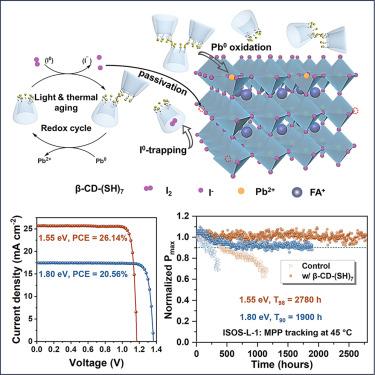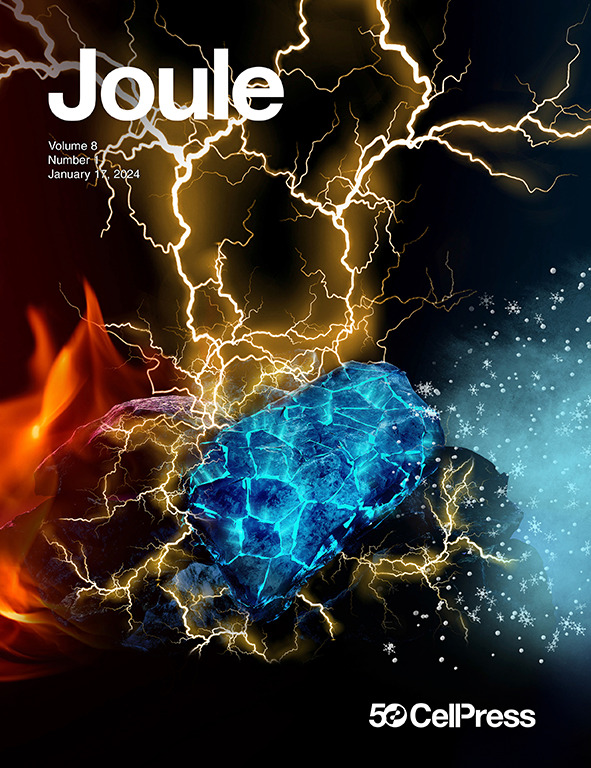钙钛矿太阳能电池的超分子工程氧化还原循环协同碘和铅螯合作用
IF 35.4
1区 材料科学
Q1 CHEMISTRY, PHYSICAL
引用次数: 0
摘要
钙钛矿太阳能电池(PSCs)由于光和热诱导的降解而遭受不稳定性,其中碘(I2)逸出和铅(Pb0)聚集引发不可逆的器件故障。在这里,我们开发了一种多功能的β-环糊精衍生物β-CD-(SH)7,协同实现碘约束,铅螯合和氧化还原循环。β-CD腔通过超分子相互作用捕获I2,而巯基通过动态S-S键形成将I2还原为I -并将Pb0氧化为Pb2+,从而实现自我持续的I -再生。β-CD-(SH)7对倒置PSCs的效率为26.14%,对有效面积为11 cm²的迷你模块的效率为23.48%。宽带隙PSCs (1.80 eV)的效率为20.56%。器件表现出优异的稳定性,在45°C的最大功率点跟踪下,T98 > 2780 h (1.55 eV)和T90 >; 1900 h (1.80 eV)。此外,β-CD-(SH)7捕获铅以防止泄漏。这种通用的超分子策略协调了效率、稳定性和可持续性,为PSC商业化提供了变革潜力。本文章由计算机程序翻译,如有差异,请以英文原文为准。

Synergistic iodine and lead chelation with redox cycling via supramolecular engineering for stable and sustainable perovskite solar cells
Perovskite solar cells (PSCs) suffer from instability due to light- and heat-induced degradation, where iodine (I2) escape and lead (Pb0) aggregation trigger irreversible device failure. Here, we developed a multifunctional β-cyclodextrin derivative of β-CD-(SH)7 that synergistically enables iodine confinement, lead chelation, and redox cycling. The β-CD cavity traps I2 via supramolecular interaction, while thiol groups reduce I2 to I− and oxidize Pb0 to Pb2+ via dynamic S–S bond formation, enabling self-sustained I− regeneration. β-CD-(SH)7 enables an efficiency of 26.14% for inverted PSCs and 23.48% for mini-modules with an active area of 11 cm². Wide-band-gap PSCs (1.80 eV) achieve an efficiency of 20.56%. The devices exhibit exceptional stability, with T98 > 2,780 h (1.55 eV) and T90 > 1,900 h (1.80 eV) under maximum power point tracking at 45°C. Additionally, β-CD-(SH)7 captures lead to prevent leakage. This universal supramolecular strategy reconciles efficiency, stability, and sustainability, offering transformative potential for PSC commercialization.
求助全文
通过发布文献求助,成功后即可免费获取论文全文。
去求助
来源期刊

Joule
Energy-General Energy
CiteScore
53.10
自引率
2.00%
发文量
198
期刊介绍:
Joule is a sister journal to Cell that focuses on research, analysis, and ideas related to sustainable energy. It aims to address the global challenge of the need for more sustainable energy solutions. Joule is a forward-looking journal that bridges disciplines and scales of energy research. It connects researchers and analysts working on scientific, technical, economic, policy, and social challenges related to sustainable energy. The journal covers a wide range of energy research, from fundamental laboratory studies on energy conversion and storage to global-level analysis. Joule aims to highlight and amplify the implications, challenges, and opportunities of novel energy research for different groups in the field.
 求助内容:
求助内容: 应助结果提醒方式:
应助结果提醒方式:


